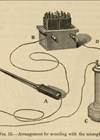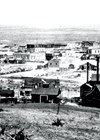In this series of articles, I am going to show you some of the exhibits contained in the Museum of Urology, hosted on the BAUS website (www.baus.org.uk).
The topic for this month’s article was stimulated by two recent occurrences. The Junior Curator came home and announced that her lecturer had described the prostates of elderly men suffering from urinary symptoms as “the size of a peach”. The following week I attended our annual regional meeting where one of my colleagues, discussing minimally invasive prostate treatments, showed a slide where prostatic size was depicted as, in increasing girth, a grape, a kiwi fruit, a lemon and an avocado.

Figure 1: A cornucopia of foodstuff, all used to describe prostatic size.
This reawakened a dormant project from the depths of my mind; we commonly, I think, describe prostatic size to our patients in terms of fruit, is this a modern affliction and if not, how long has this been going on (Figure 1)? Assisted once again by the Junior Curator, we explored this important historical question.
Anatomists and pathologists have an unfortunate habit of naming human parts and disease processes after food. The revelation that atheroma is derived from the word porridge has blighted my breakfasts since early medical school. The caseating lesions of tuberculosis of course mean ‘cheese like’ and chocolate cysts and peau d’orange skin are equally off-putting. I’m afraid we urologists are little better. How many times, when asked about the prostate gland have you used the phrase, “Oh, about the size of a walnut / apricot / plum”?
It was Niccolo Massa (1485–1569) who has been credited with first describing the prostate in 1536. He noted that the bladder rested on a fleshy gland. Andreus Vesalius (1514–1564), the famous anatomist, published the first ever illustration of the prostate in his Tabulae Anatomicae Sex, or six anatomical tables in 1538.
The earliest reference I have found, so far, to our penchant for describing the prostate in terms of the contents of a fruit bowl comes from Jean Riolan the younger (1580–1657). In his 1649 book, Anthropographia, he describes the prostate as kernels or nuts (note the plural, the prostate was then seen as two organs, left and right, rather than one organ with lobes). Thomas Bartholin (1616–1680) was more particular. In his Bartholinus Anatomy of 1665 he writes, “the prostatae .... are two kernels. They are commonly as big as a walnut”. Again, he believed that the prostate was a double gland and like Riolan implied each half resembled a kernal or nut, although he is a little more specific with his variety of nut. Thomas’ book was based on his father’s (Caspar Bartholin the Elder) anatomy textbook of 1611. Although Caspar describes the prostate, I have not been able to find any comparison with a walnut in the 1611 edition, so this must have been Thomas’ addition.
Giovanni Morgagni (1682–1771) the Italian anatomist who essentially invented anatomically based pathology, writes about the prostate as a “roundish protuberance, of the bigness of a small grape”. However, in the same book, De Sedibus et Causis Morborum, 1761 (or the seats and causes of disease), he also describes, “An excrescence of the prostate gland, in the form of a pear”. Quite a difference! The prostate of course is not only different sizes and shapes in each individual but changes over time and in the presence of disease. The latter belonged to a 70-year-old man who died at the hospital of St. Mary de Vita at Bologna of (I would guess) obstructive uropathy.
On 27 May 1817, George Langstaff (1780–1846) read a paper to the Medical and Chirurgical Society of London on fungus haematodes (soft tumours). He discussed the case of a 68-year-old pauper he had treated at the Cripplegate Workhouse, who had a tumour the size of an orange arising from the median lobe of the prostate, obstructing the ureters and with several lesions in the liver, the size of gooseberries, suggesting liver metastases. This was one of the earliest descriptions of prostate cancer in the literature and, helpfully for us, uses two fruit similes.
John Adams (1805–1877) of The London Hospital, presented a case to The Royal Medical and Chirurgical Society of London in 1853 of a ‘scirrhous of the prostate gland’. He described “an ovoid mass, distinctly scirrhous and the size of a small nut projected into the bladder”. The descriptive, ‘scirrhous’ can present some difficulties in medical history, sometimes meaning hard tumour suggesting cancer but sometimes meaning a non-cancerous growth. In this case, with involvement of the pelvic and para-aortic nodes, it was very likely malignant and like Langstaff’s case, is another early description of prostate cancer which, at the time, was thought to be a rare disease.
Sir William Fergusson (1808–1877), a pioneer of both the early lithotrite and prostatic surgery, gave us a challenge with his prostatic descriptions of a filbert and a horse bean. A filbert, we have now discovered, is an old name for hazelnut and a horse bean is a broad bean. Both appeared in his description of a perineal lithotomy operation, presented to The Pathological Society of London on 19 February 1849, where on extracting the stone, he also removed two tumours of the prostate which came away at the same time. This was an early (unintentional) perineal prostatectomy. Fergusson later suggested it could be used intentionally to remove obstructing pieces of prostate, but of course it was some years before that came to pass. Interestingly, in the following meeting, on 7 May, Mr Shaw (probably Alexander Shaw (1804–1890)) of the Middlesex, described similar ‘hazelnut’ sized prostatic tumours seen at postmortem in a patient with infected obstructive uropathy. Reginald Harrison (1837–1908) described another case like Fergusson’s in 1882, enucleating a ‘walnut’ of prostate at lithotomy. It was not until 1887, that Arthur McGill (1850–1890) of Leeds and William Belfield (1856–1929) in the USA began purposefully enucleating obstructive portions of the prostate. Incidentally, Belfield gave us more ‘hazelnut sized and pear shaped’ prostatic myomas to add to our list in 1886.
Unsurprisingly, the prolific urological writers of the 19th century contributed significantly to the prostatic cornucopia. Sir Henry Thompson (1820–1904) felt the adult prostate to be generally the size of a horse chestnut. However, in diseased states he described one as the size of a small orange and, in perhaps the largest offering, another the size of a coconut, which filled the pelvis.
Sir Peter Freyer (1851–1921), one of the pioneers of early ‘intentional’ prostatectomy had, by 1920 carried out 1674 enucleations. He gave us another example as large as an orange but also, like the anatomists of old, used different food to describe the lobes, with the lateral lobes as walnuts and the median lobes as gooseberries.
Finally, moving from fruit bowl to larder, both Mr Edwin Bickersteth (1828–1908) and W Bruce Clarke (1850–1914) described the enlarged prostate as the size of a hen’s egg.
All the historic descriptions I have found however, were written for other doctors, describing the anatomy and pathology of the prostate or pieces thereof. So, what about the patients and what do we tell patients now? Over to the Junior Curator.

An internet search using Google with the parameters, “How big is my prostate?”, “Prostate size” and “What is the size of the prostate” was carried out (January 2025). We excluded the AI overview and looked at the first 15 results. The first 11 websites all used fruit or nut similes to give an estimate of prostatic size, often using more than one when discussing age-elated enlargement. The final fruit bowl containing eight walnuts, three lemons, two apricots, a chestnut, an orange and a plum. However, unlike our historical references, the sports field has now been added to the kitchen with golf, tennis and ping-pong balls appearing (Table 1). In the final four of the 15 sites reviewed, descriptions were given in measurements. This then prompts the question, what would a patient better understand, your prostate is: “20-30 grams”, “1.2 x 1.8 x 0.8 inches” or “the size of a walnut”?









